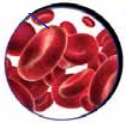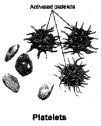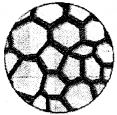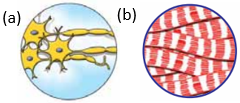Kerala Syllabus 8th Standard Basic Science Solutions Chapter 2 Cell Clusters
Kerala Syllabus 8th Standard Basic Science Solutions Chapter 2 Cell Clusters
Kerala State Syllabus 8th Standard Basic Science Solutions Chapter 2 Cell Clusters
Cell Clusters Questions and Answers
Diversity among cells
Each part of human body is composed of different kinds of cells. These cells do not act independently. But they act in groups of similar cells. These cell clusters are called tissues.

Cell Clusters Class 8 Kerala Syllabus Tissues
The group of cells with common origin and perform a specific function are called tissues. The coordinated action of tissue, help to perform various physiological functions effectively.
Cell Differentiation
The single celled zygote divides continuously and forms the foetus that consists of cells differ in shape, size and contents. Foetal cells gradually attain change in structure and function. This process is called cell differentiation.
Indicators (Text Book Page No:24)
Cell Clusters Class 8 Notes Pdf Kerala Syllabus Question 1.
Formation of foetus.
Answer:
The single celled zygote formed by the fusion of sperm and ovum continuously divides and the foetus is formed.
8th Class Biology Notes Pdf Kerala Syllabus Question 2.
Significance of cell differentiation.
Answer:
Foetal cells gradually attain change in structure and function due to cell differentiation. Thus, different kinds of cells and tissues are formed. It helps to make the life processes effective.
Kerala Syllabus 8th Standard Biology Notes Stem cells
Stem cells are specialised cells that can be transformed into any kind of cells.
Stem cells can either transform into other cells through division or they can exist as such. When the cells in the tissues, get destructed, new cells emerge from stem cells.
It is expected that the research of stem cells may cause drastic change in the treatment of blood cancer, diabetes, Parkinson’s disease etc as desired cells are formed from stem cells.
Indicators (Text Book Page No:25)
Class 8 Science Notes Kerala Syllabus Question 3.
What are the peculiarities of stem cells when compared to other cells?
Answer:
Stem cells are specialized cells that can be transformed into any kind of cell. They can either transform into other cells or can retain their existence. When the cells in the tissues get destroyed new cells originate from stem cells.
Cell Clusters Class 8 Questions And Answers Pdf Kerala Syllabus Question 4.
How is the destruction of cells in tissues compensated?
Answer:
When the cells in the tissues get destroyed, new cells originate from cells. Stem cells are found in bone marrow, skin, digestive fact etc.
Cell Clusters Class 8 Notes Kerala Syllabus Question 5.
Why is stem cell research gaining importance?
Answer:
Nowadays desired cells can be produced from stem cells in research laboratories. The research of stem cells can cause a drastic change in the treatment of blood cancer, diabetes, Parkinson’s diseases etc, and in the production of artificial organs.
Animal Tissues
Animal tissues are mainly classified into 4
(a) Epithelial tissue
(b) Nervous tissue
(c) Muscular tissue
(d) Connective tissue
1. Epithelial Tissue:- Covers and protects the body.
Covers the inner lining of the alimentary canal Performs the functions like protection, absorption, production of secretions, etc.
2. Nervous Tissue:- Controls and Co-ordinates physiological Activities Helps to respond to particular stimuli
3. Muscular Tissue:- Makes the movement of the body possible.
4. Connective Tissue:-
- Connects different tissues.
- Provide support and strength to the body
- Performs the functions like material transport, defence, etc.
Meristematic tissues Meristematic cells are specialized cells seen at the tip of the stem and root in plants. They divide rapidly and helps in the growth of plants.
Table (Text Book Page No:27)
Compare the figures of a meristematic cell and a mature cell. Find out the differences and complete the table.

Answer:
| Characteristics | Meristematic Cells | Mature plant Cells |
| Relative size of Nucleus | (a) ………………. | (b) …………… |
| Thickness of cell wall | (c) ………………. | (d) …………… |
| Quantity of Cytoplasm | (e) ………………. | (f) …………… |
Basic Science Class 8 Chapter 2 Kerala Syllabus Various Plant Tissues
Parenchyma, Collenchyma, and Sclerenchyma are the main plant tissues. They differ in structure and perform different functions.
The specialised tissues in plants that conduct water and salts that are absorbed by the roots to the leaves and the food prepared in the leaves to various parts, are called vascular tissues. These are called complex tissues as they are. formed by different types of cells. Xylem and Phloem are the main vascular tissues.
Work sheet (Text Book Page No:30)

Answer:

- Organs like stomach and Intestine are mainly formed by nervous tissue, epithelial tissue, connective tissue, and muscular tissue.
- Temporary storage of food materials, digestion and the secretion of digestive juices.
- Complete digestion of food materials. Secretion of-digestive juices, reabsorption of water, absorption of nutrients.
- Organ performs the co-ordinated functions of various tissues. The function of an organ is not the same as that of the individual tissues which constitute the organ.
- Various organs combine to form organ system. As a result physiological functions can be performed very effectively.
eg: teeth, tongue, glands, oesophagus, stomach, small intestine, large intestine etc constitute digestive system. It enables the complete digestion of food.
Table (Text Book Page No:31)
Complete the following table by finding out the systems to which the organs listed in the table belong to:

Answer:
| Organs | Organ System |
| Heart, Blood vessels | Circulatory System |
| Nose, Trachea, Lungs. | Respiratory System |
| Kidney, Ureter, Urinary bladder | Excretory System |
| Brain, Nerves | Nervous System |
An organism is composed of various organ systems. Therefore the structure of organisms is highly complicated.
Cells are the basic unit of life. Cell parts are composed of different substances.
In higher organisms diverse tissues act complementary to each other and perform various life processes.
Cell Clusters Let us assess (Text Book Page No:33)
Given below in the illustration are various tissues related to the structure of hand.

Answer:
1. • A
• C
2. Formed from various cells
3. Only the corners of the cells are thicked
Cell Clusters Text Book Questions and Answers
Question 1.
Arrange an exhibition showing pictures and descriptions of different types of cells.
Answer:
Cell
Cell is the structural and functional unit of life.
• All organisms are formed of one or more cells.
• All vital activities of life take place inside the cells.
• Here dietary information that controls the functions of the cells are contained in the cell.
• There are three types of cells in the blood. Red blood cells, white blood cells and platelets.
Red Blood cells

Red blood cells are the most abundant cells in the blood. They are also known as erythrocytes. Invertebrates, RBC carries oxygen to the tissues. In RBC, the cytoplasm contains an iron containing biomolecule, the haemoglobin. If in parts red colour to the blood. In human, RBCs has biconcave disc shape.
White blood cells

WBC’S are also called leucocytes, they protect the body from pathogens and other antigens as a part of the immune system. They are formed from the stem cells of the bone marrow. The number of WBCs is an indicator of health. They are classified into neutrophil, eosinophil, basophil, monocyte and lymphocyte according to the diversity of cytoplasm, nucleus etc.
Platelets

They are also known as thrombocytes. They help in the coagulation of blood. They are formed from the cells called megakaryocytes.
Question 2.
Prepare a magazine specifying the importance, relevance, and scope of stem cells.
Answer:
Stem cell
Stem cell are specified cells that can transform to any kind of cell. They are also known as root cells. They transform to other cells by a long process of differentiation.
Stem cells can either transform to other cells or exist as such. When the cell in the tissues get destructed, new cells originate from stem cells. Stem cells are seen in bone marrow, skin, digestive tract etc.
Today it is possible to develop desired cells from stem cells under specific conditions of laboratories. It is expected to make tremendous change in the treatment of blood cancer, diabetes, parkinson’s diseases etc. and in the development of artificial organs through the research works of in stem cells.
Cell Clusters Additional Questions and Answers
Question 1.
Findi the odd one in each group.
Also write the common characterestic of the others.
a. Collenchyma, Sclerenchyma Xylem, Nervous tissue.
b. Blood, Muscle, ligament, Bone
c. Basophil, Platelet, Neutrophil, Lymphocytes
d. Collenchyma, Aerenchyma, Parenchyma, Chlorenchyma
e. Intercalary meristem, Primary meristem, Apical meristem, Lateral meristem
f. Xylem, Collenchyma, Scler-enchyma, Parenchyma.
g. Man, Pigeon, Duck, Amoeba
h. Large intestine, Digestive tract, Heart, Stomach
i. Bony tissue, Muscular tissue, Cartilaginous tissue, Blood
j. Parenchyma, Collenchyma, Epithelial tissue, Sclerenchyma.
Answer:
a.Nervous tissue; Others are plant tissues.
b. Muscle, Others are connective tissues.
c. Platelets, Others are white blood cells.
d. Collenchyma, Others are the different forms of parenchyma.
e. Primary meristem : Others are divide and new tissues. Primary meristem divide and from apical meristem and lateral meristem.
f. Xylem : It is conduction tissue and others are basic tissues.
g. Amoeba – Cell level organism and
others are organ system level organisms.
h. Heart : It is a circulatory organ. Others are digestive organ.
i. Muscular tissue : The others are connective tissues
j. Epithelial tissue : The others are plant tissues.
Question 2.
Find out the relation between the given word pairs and on that basis fill in the blanks.
a. Water and salts : xylem :: ………… : Phloem
b. Photosynthesis : Parenchyma : Support and Strength : ………..
c. Between bones and muscles : tendons ; Between bones and bone: ………..
d. Blood : Connective tissue : : Skin: ……….. ;
e. Control and Co-ordination : Nervous tissue : : Body Move ment:: ………..
f. Fibrous tissue : Connectother tissue; ……….. : Transport of materials
g. Storage of food : ……….. ; Flexibility to plant parts : Col-lenchyma
h. White blood cells : ……….. ; Redblood cell; O2 transportation
i. Xylem – ………..; Phloem: Transports synthsised food
j. Intercalary meristem : Inter node lengthening; Lateral meristem: ………..
k. Aerenchyma : Air cavities ; Chlorenchyma : ………..
l. Cell :Tissue; system : ………..
Answer:
a. Food
b. Sclerenchyma
c. Ligaments
d. Epithelial Tissue
e. Muscular Tissue
f. Blood
g. Parenchyma
h. Immunity
i. Transports water and minerals
j. Thickening of stem
k. Chlorophyll
l. Organ
Question 3.
Complete the flowchart which shows levels of organisation of human being.

Answer:
a. cell organelle
b. Organ
Question 4.
Observe the following figure and answer the given questions.

a. Find out correct one from the bracket shows the plant tissue given in the figure.
A. parenchyma
B. sclerenchyma
C. xylem
D. collenchyma
b. Write down the characteristic features of the plant cell in the given figure?
c. Give scientific explanation for the features of plant part are given below.
i. Desterity of shaft of colacasia.
ii. Hardness of shell
Answer:
a. B. sclerenchyma
b. composed of cells that are uniformly thick all over the cell wall.
c. i. presence of collenchyma cells, ii. presence of sclerenchyma cells.
Question 5.
Find out wrong items from the following statements, and also correct their underlined words.
a. Sclerenchyma can provides strength and support to plant parts.
b. Fibrous tissue can enables to respond by identifying the changes inside and outside the body.
c. Production of secretion is one of the function of Epithelial tissue.
d. muscular tissue enables the movement of the body.
Answer:
- b, d are wrong statements.
- b. Nervous tissue can enables to respond identifying the changes inside and outside the body.
- d. Muscular tissue enables the movement of the body.
Question 6.
What is the difference between blood and blood circulatory system?
Answer:
Blood is a tissue in the blood circulatory system. But blood vessels, heart, nerves, etc. are the other factors of the blood circulatory system. The combined work of all these factors form the blood circulatory system.
Question 7.
All parts of the plant do not grow. Why?
Answer:
In plants, only the meristematic cells have the ability to divide and grow. Meristematic cells are mainly found in the root apex and stem apex. So the plant growth is concentrated at the root apex and stem apex.
Question 8.
What are tissues? Give examples.
Answer:
A group of similar cells is called tissue
eg : Parenchyma
Question 9.
“Body is composed of millions of cells. Are they perform the same function? How do they act independently?”
This is question raised in the class by the teacher for a discussion. What will be your answer to this question?
Answer:
Cells act in groups of similar kind. Group of similar cells that are originated from a single cell and perform a specific function are called tissues. They perform different functions.
Eg: muscular tissue, Nervous tissue, Epithelial tissue.
Question 10.
Our body is developed from a single-celled zygote. How do this much organs and organ system sare formed in our body?
Answer:
Zygote divides continuously and forms the foetus that consists of cells differ in shape, size, and content. Foetal cells gradually attain diversity in structure and function. Thus different organs and organ systems are formed.
Question 11.
| Stem cells for Cancer treatment |
| Tvm:- Scientists say that the production of tissues from stem cells may cause drastic change in the treatment of Cancer… |
Did you read the news report? What are stem cells? How do they become useful in the treatment of Cancer?
Answer:
Stem cells are specialized cells that can be transformed to any kind of cell. Stemcells modify to other cells through prolonged differentiation. When cells destroyed, new cells originates from stem cells. In research laboratories desired cells are formed from stem cells. New cells, instead of cancer cells, can be produced from stem cells.
Question 12.
Complete the given flow chart

Answer:
a. Nervous Tissue
b. Connective Tissue
c. • Covers and protects the body
• The inner lining of alimentary ‘ canal
• Perform the function of protection, absorption, production of secretion, etc.
d. helps to respond by recognizing the changes within and out of the body
e. Makes the movement of body possible.
Question 13.
Categorise the given statements under suitable headings.
1. Provide shape to body.
2. Defence
3. Covers and protects internal organs.
4. Conduction of respiratory gases.
Answer:
| Blood | Bone, Cartilage (Connective Tissue) |
| 2. Defence | 1. Provide shape to body. |
| 4. Conduction of respiratory gases. | 3. Covers and protects internal organs. |
Question 14.
Identify the figures given below.
Answer:

a. Nervous tissue
b. Muscular tissue
Question 15.
What are the differences between the process of growth in plants and animals?
Answer:
Plant growth
- Plants grow throughout their life.
- In plants, growth is mainly restricted at the tips of stem and root(meristem)
Animal growth
- Animals grow upto a particular period
- In animals, growth is not confined to any specific regions.
Question 16.
Why plant growth is confined to specific parts?
Answer:
In plants, specific cells called meristematic cells are concentrated the tips of roots and stems. They have the ability to divide rapidly.
Question 17.
Complete the table properly
| Characteristics | Meristematic Cells | Mature Cells |
| Relative size of Nucleus | (a) ………………. | (b) …………… |
| Thickness of cell wall | (c) ………………. | (d) …………… |
| Quantity of Cytoplasm | (e) ………………. | (f) …………… |
Answer:
a. Comparatively large nucleus
b. Small nucleus
c. Thin cell wall
d. Thick cell wall
e. More
f. Comparatively less
Question 18.
How do the water and salts absorbed by the roots reach the leaves?
Answer:
In plants, the water and salts absorbed by the roots are transported to the leaves through specialised tissues called vascular tissues.
Question 19.
Vascular tissues are called complex tissues. Why?
Answer:
Vascular tissues are formed by the union of different types of cells. Hence they are called complex tissues.
Question 20.
Picture of section of stem is given. Label the parts.

Answer:
a. Collenchyma
b. Parenchyma
c. Sclerenchyma
d. Phloem
e. Xylem
Question 21.
Pair the given cells with their specific character
| Parenchyma, Collenchyma, Sclerenchyma. |
a. formed of cells whose cell wall is uniformly thickened in all parts.
b. seen in tender parts of plant.
c. formed of cells whose cell wall has thickenings in the comers only
Answer:
parenchyma – b
Collenchyma –
c sclerenchyma – a
Question 22.
Write examples for vascular tissues?
Answer:
Xylem and Phloem
Question 23.
Arrange the given statements in the right column.
1. Formed of inter related cells seen as ducts.
2. Carries water and salts absorbed by the roots to the leaves.
3. Carries the food prepared in the leaves to various plant parts.
4. Provide support and strength to plant

Answer:
Xylem 2, 4 Phloem -1, 3
Question 24.
Complete the worksheet based on the hints given.

Hints
A. Carries the food prepared in the leaves to various plant parts.
B. Carries water and salts absorbed by the roots to the leaves.
C. Seen in the tender parts of the leaves.
D. Thickenings seen only in the corners of the cell wall
E. Cells have uniform thickenings in the cell wall.
Answer:
A – Phloem
B – Xylem
C – Parenchyma
D – Collenchyma
E – Sclerenchyma
Question 25.
Which are the tissues that constitute the organs like stomach and intestine?
Answer:
Nervous tissue, Epithelial tissue, Connective tissue, Muscular tissue
Question 26.
Identify the organ system to which the given organs are associated?
a. Heart, Blood Vessels
b. Nose, trachea, lungs
c. Kidney, Ureter, Urinary Bladder.
d. Brain, Nerves
Answer:
a – Circulatory system
b – Respiratory system
c – Excretory system
d – Nervous system
Question 27.
Which of the statements is not related to tissues?
a. Different types of cells are seen.
b. Similar kind of cells are seen.
c. Performs specific function.
d. Formed from different cells
Answer:
d. Formed from different cells
Question 28.
Which indicator helps to identify collenchyma when tissues are observed through a microscope.
a. No thickenings in the cell wall.
b. all parts of the cell wall is thick,
c. No nucleus in the cell
d. Thickenings are seen only in the comers of the cell.
Answer:
d. Thickenings are seen only in the comers of the cell.
Question 29.
Complete the flow chart showing the levels of organization in organisms

Answer:
a. tissue
b. Organ system
c. Organism
d. Species
Question 30.
What is meant by voluntary muscles and involuntary muscles? Give examples:
Answer:
Tissues that work according to our wish are called voluntary muscles.
eg: muscles of limbs.
Muscles which works independently and are out of our control are called involunatary muscles.
eg : Muscles of the alimentary canal, muscles of the eyelids, etc.
Question 31.
Xylem vessels are thicker than phloem vessels. Why?
Answer:
The cell wall of the xylem vessels is comparatively thicker than that, of the phloem vessels. Lignin is used to make the cell wall strong. So the xylem vessels are thicker.
